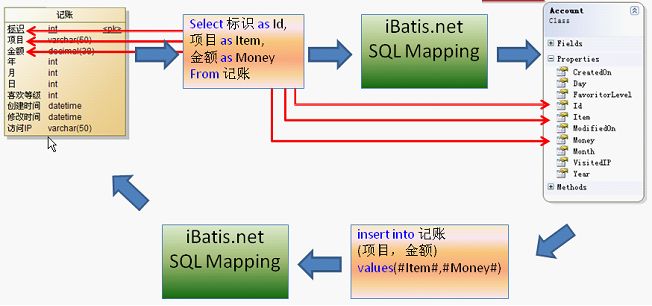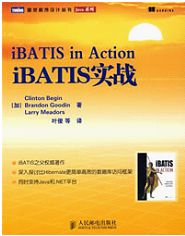iBatis.net入门指南
iBatis.net入门指南
情景一 基本标签(insert,update ,select)及属性(parameterClass,resultClass) - 5 -
情景二 子标签(<sql /><include />)及转义处理 - 7 -
情景三 高阶标签(<dynamic />)及属性(resultMap) - 8 -
情景四 储存过程标<procedure/>及属性parameterMap - 10 -
![]()
![]()
参与人员:
作者 |
联系方式 |
毛凌志 |
|
发布记录
版本 |
日期 |
作者 |
说明 |
0.0 |
2009-08-21 |
毛凌志 |
初稿 |
什么是iBatis.net ?
以SQL Mapping为核心,提供基于ado.net之上的一层简单抽象,将数据库中数据映射到领域模型的持久层框架
iBatis.net的原理
新人指路
-
新建工程,添加2个引用文件
-
添加并修改配置3个配置文件
-
根据数据库的表结构及业务设计领域模型(可以手动,或利用codesmith等生成器半自动完成
-
由模板或手动生成SQL Mapping文件(e.g.Account.xml),并根据业务需求撰写sql语句
更详细的使用过程,可参见视频。
iBatis.net的优缺点
优点 |
缺点 |
|
|
SQL Mapping金典案例
情景一 基本标签(insert,update ,select)及属性(parameterClass,resultClass)
在iBatis.net原理一节示例了使用ibatis.net进行insert和select操作,下面展示介绍如何具体的进行SqlMapping。
在SqlMapping的配置文件本例中为Account.xml文件中,添加如下的标签段
并将此Account.xml文件的路径加入到sqlmap.config中
在iBatis.net中提供了五种常用的标签如下表示
表1 基本SQL Mapping标签
标签 |
说明 |
<insert></insert> |
删除sql语句 |
<update></update> |
更新sql语句 |
<select></select> |
选取sql语句 |
<delete></delete> |
删除sql语句 |
<procedure></procedure> |
调用储存过程 |
在这些容器标签中有一些常用的属性如下所示
属性 |
说明 |
Id |
用于唯一标识一条sql语句 |
resultClass |
用于将sql语句返回的字段和resultClass提定的类进行隐式的自动映射 |
parameterClass |
用于指定输入参数的类型,如果输入参数有多个应使用Hashtable或是类进行包装 |
下面是关于这两条SQL语句的调用方法和测试
情景二 子标签(<sql /><include />)及转义处理
在一些复杂的情景中,为了简化SQL的编写工作,ibatis.net提供了一些标签用于简化SQL的编写操作。可以将可复用的sql语句写在<sql></sql>标签中,然后中<select/><insert/><update/><delete/>等标签中使用<include refid="xxx" />进行引用,其中refid属性指向<sql/>子标签的标识id。
如下例中所示
在此例中,我们还使用了了<![CDATA[]]>,主要是在sql语句中有些特殊的字符如<>等,在xml中不能直接使用,因为我们将包含特殊字符的 SQL语句放入XML的CDATA块中
在此例中,通过Hashtable传入了两个参数,下面介绍了程序中是如何调用上面这段代码的
情景三 高阶标签(<dynamic />)及属性(resultMap)
当在进行一些组合查询等需要灵活组装sql的情景时,需要用到dynamic标签。如下所示。
这段代码可以大至翻译为如下的伪代码
Account acc=new Account();
acc.Item="买菜";
if(acc.Item!=null)
sql+="where item like '%"+acc.Item+"%'";
If(acc.Money!=null)
sql+="or Money like '%20%';
this.Response.Write(sql)
表3 <dynamic>元素
名称 |
描述 |
isEqual |
如果参数相等于值则查询条件有效 |
isNotEqual |
如果参数不等于值则查询条件有效 |
isGreaterThan |
如果参数大于值则查询条件有效 |
isGreaterEqual |
如果参数大于等于值则查询条件有效 |
isLessEqual |
如果参数小于值则查询条件有效 |
isPropertyAvaiable |
如果参数可用则查询条件有效 |
isNotPropertyAvaiable |
如果参数不可用则查询条件有效 |
isNull |
如果参数为Null则查询条件有效 |
isNotNull |
如果参数不为Null则查询条件有效 |
isEmpty |
如果参数为空则查询条件有效 |
isNotEmpty |
如果参数不为空则查询条件有效。参数的数据类型为Collection、string时参数不为 NULLo "" |
isParameterPresent |
如果参数类为Null则查询条件有效 |
isNotParameterPresent |
如果参数类不为Null则查询条件有效 |
在上面的属性中使用了resultMap属性,原先使用resultClass是自动隐式的将sql语句映射出的字段。而resultMap属性用于将select输出的语句进行显示的映射, 如下所示
将sql语句取出数据的字段名名称和领域模型进行一个显示的映射。
情景四 储存过程标<procedure/>及属性parameterMap
在SQL Mapping中专门为储存过程提供了标签,如下所示:
其调用方法是在容器标签中撰写储存过程的名称,此写法适合SQL Server,针对其它数据库的方法参见储存过程调用方法。
注意到在这里我们使用了一个新的属性parameterMap,它的作用是对输入的参数进行显示的映射,之前在情景一中介绍过parameterClass,它和parameterMap类似均是用来对传入sql的参数时行映射,不同的是对parameterClass是隐式映射的,而parameterMap是显示的映射。
注意到,有一个direction属性默认为储存过程的in,可以特别指定用于其它的方式如out或inout等。
在这里我们也使用了resultMap属性,该属性已在情景三中进行了介绍,读者忘了可以再温习一下
关于储存过程的具体的调用方法参见如下的示例,该储存过程的作用是对Accounts表进行分页返回指定页面的记录数和总的记录数。
ISqlMapper接口
当我们执行SQL语句取出需要的数据库,也做了SQL Mapping的映射,最终我们的目的是希望将取出的数据以我们需要的形式(或者说是数据结构)呈现给我们。那么ISqlMapper接口就是来实现这一操作的,如下图所示。
方法 |
说明 |
QueryForObject<T>(string,object) |
Overloaded. Executes a Sql SELECT statement that returns a single object of the type of the resultObject parameter. |
QueryForList<T>(string,object) |
Overloaded. Executes a Sql SELECT statement that returns data to populate a number of result objects. The parameter object is generally used to supply the input data for the WHERE clause parameter(s) of the SELECT statement. |
QueryForDictionary<K,V>(string,object,string,string) |
Overloaded. Executes the SQL and retuns all rows selected in a map that is keyed on the property named in the keyProperty parameter. The value at each key will be the value of the property specified in the valueProperty parameter. If valueProperty is null, the entire result object will be entered. |
Insert(string,object) |
Executes a Sql INSERT statement. Insert is a bit different from other update methods, as it provides facilities for returning the primary key of the newly inserted row (rather than the effected rows). This functionality is of course optional. The parameter object is generally used to supply the input data for the INSERT values. |
Update(string,object) |
Executes a Sql UPDATE statement. Update can also be used for any other update statement type, such as inserts and deletes. Update returns the number of rows effected. The parameter object is generally used to supply the input data for the UPDATE values as well as the WHERE clause parameter(s). |
Delete(string,object) |
Executes a Sql DELETE statement. Delete returns the number of rows effected. |
深度私塾
向sql语句中传入多个参数
参见情景二
自动生成键selectkey
在数据库插入一条数据的时候,经常是需要返回插入这条数据的主键。但是数据库供应商之间生成主键的方式都不一样。
有些是预先生成(pre-generate)主键的,如Oracle和PostgreSQL;有些是事后生成(post-generate)主键的,如MySQL和SQL Server。但是不管是哪种方式,我们都可以用iBATIS的节点来获取语句所产生的主键。
Oracle
<insert id="insertProduct-ORACLE" parameterClass="product">
<selectKey resultClass="int" type="pre" keyProperty="id" >
SELECT STOCKIDSEQUENCE.NEXTVAL AS VALUE FROM DUAL
selectKey>
insert into PRODUCT (PRD_ID,PRD_DESCRIPTION) values (#id#,#description#)
insert>
SqlServer
<insert id="insertProduct-MS-SQL" parameterClass="product">
insert into PRODUCT (PRD_DESCRIPTION)
values (#description#)
<selectKey resultClass="int" type="post" keyProperty="id" >
select @@IDENTITY as value
</selectKey>
</insert>
MySQL
<insert id="insertProduct-MYSQL" parameterClass="product">
insert into PRODUCT (PRD_DESCRIPTION)
values (#description#)
<selectKey resultClass="int" type="post" keyProperty="id" >
select LAST_INSERT_ID() as value
</selectKey>
</insert>
SQLite
<insert id="Create" parameterClass="Subject">
INSERT INTO SUBJECT
(SubjectName,QuestionCount,IsNowPaper)
VALUES(#SubjectName#,#QuestionCount#,#IsNowPaper#)
<selectKey resultClass="int" type="post" property="SubjectId">
SELECT seq
FROM sqlite_sequence
WHERE (name = 'SUBJECT')
</selectKey>
</insert>
储存过程调用方法
SqlServer
<parameterMap id="pm_ErickPagination" class="System.Collections.Hashtable">
<parameter property="PageSize"/>
<parameter property="CurrentPage"/>
<parameter property="TotalCount" column="TotalCount" direction="Output" />
</parameterMap>
<procedure id="sp_ErickPagination"
parameterMap="pm_ErickPagination"
resultMap="FindAllResult">
ErickPagination
</procedure>
Oracle
<parameterMap id="userParam" class="user">
<parameter property="username"/>
<parameter property="email"/>
</parameterMap>
<procedure id="sendEmail" parameterMap="userParam">
{call sendMail(?,?)}
</procedure>
















